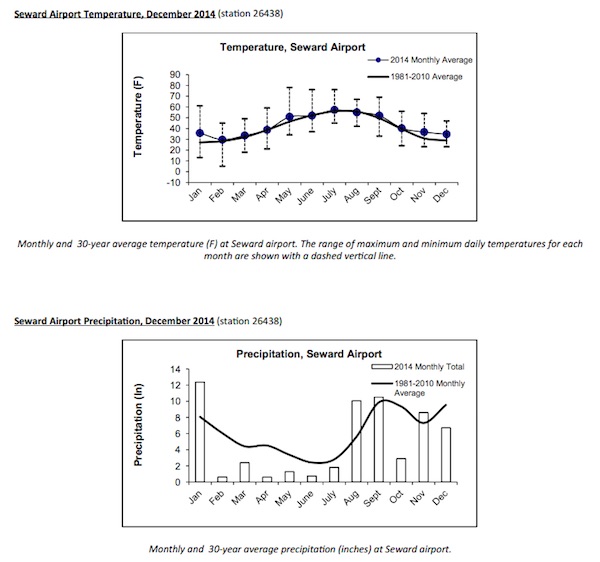Things are warming up in Alaska, and that's not a good thing. At Kenai Fjords National Park, the average monthly temperature in December was nearly 6 degrees Fahrenheit above normal, the same departure noticed in November. Just one day in December saw temperatures dip below freezing, as measured at the Seward airport.
A release from the park added that the average daily high and low temperatures were both above normal, exceeding their respective averages by 5.1 and 6.5 degrees F.
The combination of below-normal monthly precipitation and warmer-than-normal temperatures resulted in little snowfall and no snow accumulation at lower elevations. The existing snow pack near Exit Glacier lost 3.9 inches of snow in December, leaving only 4.8 inches of snow at the Exit Glacier as measured for the January 1st snow survey, and no snow on the ground in town, the release said.
"Of the 14 measurements completed in the last 28-year period of record at Exit Glacier, the 2014-2015 measurement is the lowest January 1st snow pack. It is 13.8 inches below the previous lowest measurement of 18.6 inches recorded January 1, 1991," the staff noted.
As recorded at the Seward airport, the monthly average temperature for December was 34.7 degrees F; 5.8 degrees F above the 30-year normal. The total precipitation was 6.8 inches (71 percent of normal), 2.74 inches below the 30-year normal (1981-2010) for the month.
Also of note:
* The National Weather Service Climate Prediction Center's three-month weather outlook (January-February-March) favors above-normal temperatures and above-normal precipitation for the Kenai Fjords area.
* The Institute on the Environment at the University of Minnesota’s online environmental magazine, Ensia, summarizes numerous changes indicating that, “the Arctic we know is coming to an end…a new and very different Arctic is taking over.”
* NOAA’s Climate.gov reports that 2014 was the tenth consecutive year with below-average spring snow cover in the Northern Hemisphere.
* NASA’s Earth Observatory reports a 5 percent increase in the amount of solar radiation absorbed by the Arctic during summer months in the 21st century resulting from decreased sea ice.


 Support Essential Coverage of Essential Places
Support Essential Coverage of Essential Places






